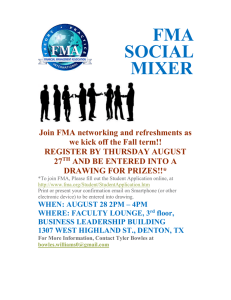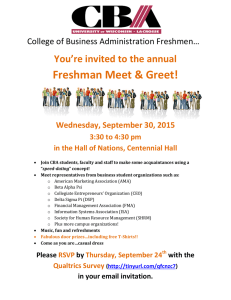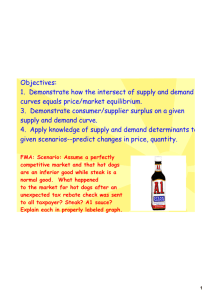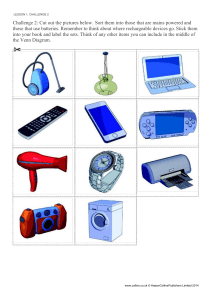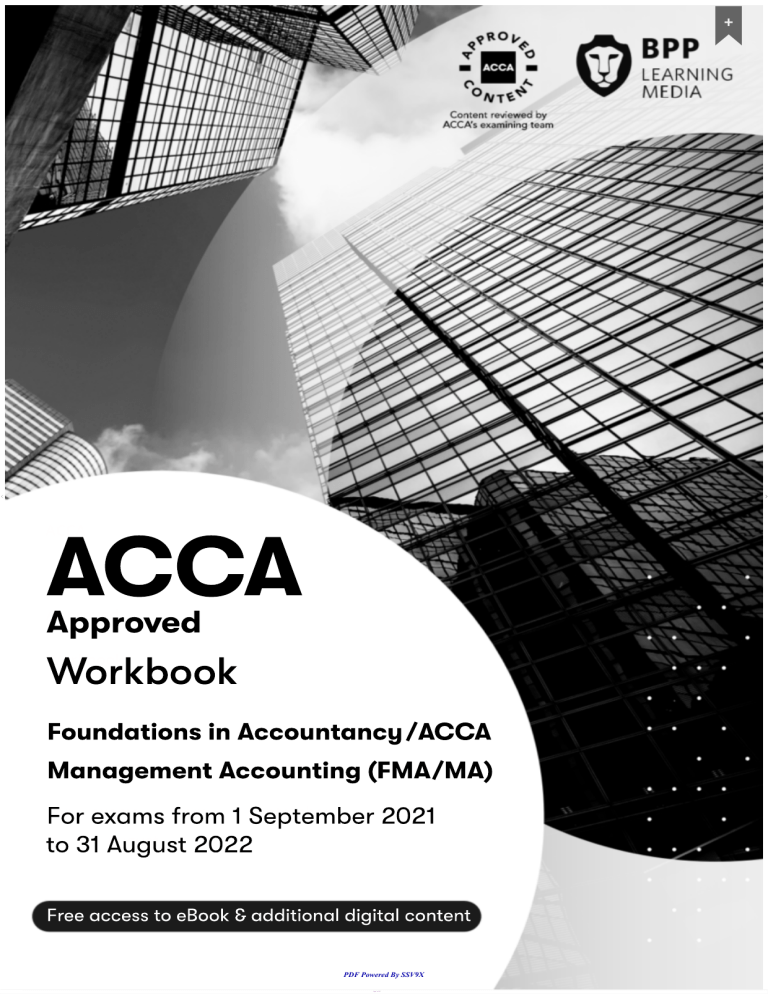
q G H ACCA Approved Workbook Foundations in Accountancy/ACCA Management For Accounting exams from to 31 August Free access 1 September (FMA/MA) 2021 2022 to eBook & additional digital content PDF Powered By SSV9X Page 1 of 687 q Foundations in Accountancy/ACCA Management Accounting (FMA/MA) G H Workbook For exams from September August 2021 1st to 31st 2022 PDF Powered By SSV9X Page 2 of 687 G q Firstedition2021 Anoteaboutcopyright DearCustomer Whatdoesthelittle©meanandwhydoesitmatter? Yourmarket-leading BPPbooks,coursematerialsand e-learningmaterialsdonotwriteandupdate themselves. Peoplewritethemontheirownbehalfor as employees ofan organisation thatinvestsinthis activity.Copyrightlawprotectstheirlivelihoods. It doessobycreatingrightsovertheuseofthecontent. Breachofcopyrightisa formoftheft– as wellas beinga criminal offenceinsomejurisdictions, itis potentially a seriousbreachofprofessional ethics. Withcurrenttechnology,thingsmightseema bit hazybut,basically,withouttheexpresspermission of BPPLearning Media: • Photocopying ourmaterialsisa breachof copyright • Scanning,ripcastingorconversion ofourdigital materialsintodifferentfileformats,uploading themtoFacebookoremailingthemtoyourfriends isa breachofcopyright Youcan,ofcourse,sellyourbooks,intheformin whichyouhaveboughtthem– onceyouhave finishedwiththem.(Isthisfairtoyourfellowstudents? Weupdatefora reason.)Pleasenotethee-products aresoldona singleuserlicencebasis:wedonot supply‘unlock’ codestopeoplewhohavebought themsecond-hand. AndwhataboutoutsidetheUK?BPPLearning Media strivestomakeourmaterialsavailableat prices studentscanaffordbylocalprintingarrangements, pricingpoliciesandpartnerships whichareclearly listedonourwebsite.Atinyminority ignorethisand indulgeincriminal activitybyillegally photocopying ourmaterialorsupportingorganisations thatdo.If theyact illegally andunethically inonearea,canyou reallytrustthem? ISBN 9781509738618 ISBN (forinternaluseonly):9781509738601 e-ISBN 9781509739103 BritishLibraryCataloguing-in-Publication Data Acataloguerecordforthisbookisavailablefromthe BritishLibrary. Publishedby BPPLearning MediaLtd BPPHouse,Aldine Place 142–144 Uxbridge Road LondonW128AA learningmedia.bpp.com PrintedintheUnitedKingdom Yourlearningmaterials,publishedbyBPP Learning MediaLtd,areprintedonpapersourced fromsustainable, managedforests. Allrightsreserved.Nopartofthispublication maybe reproduced, storedina retrievalsystemor transmitted, inanyformorbyanymeans,electronic, mechanical, photocopying, recordingorotherwise, withoutthepriorwrittenpermission ofBPPLearning MediaLtd. Thecontentsofthisbookareintendedas a guideand notprofessional advice.Although everyefforthas beenmadetoensurethatthecontentsofthisbook arecorrectat thetimeofgoingtopress,BPPLearning Mediamakesnowarrantythattheinformation inthis bookisaccurateorcompleteandacceptnoliability foranylossordamagesufferedbyanypersonacting orrefraining fromactingas a resultofthematerialin thisbook. WearegratefultotheAssociation ofChartered CertifiedAccountants forpermission toreproduce pastexamination questionsandextractsfromthe syllabus.Thesuggestedsolutions inthepractice answerbankhavebeenpreparedbyBPPLearning MediaLtd,exceptwhereotherwise stated. ©BPPLearning MediaLtd 2021 PDF Powered By SSV9X Page 3 of 687 H G q Contents Introduction Helping you to pass v Introduction to the Essential reading vii Introduction to Management Accounting (FMA/MA) ix Essential skillsareas to be successful in Management Accounting (FMA/MA) xii 1 Accounting for management 1 2 Data and presenting information 17 3 Cost classification and behaviour 41 4 Forecasting 65 5 Summarising and analysing data 99 Skillscheckpoint 1 127 6 Accounting for materials 135 7 Accounting for labour 167 8 Accounting for overheads 187 9 Process costing 223 10 Costing methods 251 11 Setting budgets 279 12 Implementing budgets 303 Skillscheckpoint 2 317 13 Project appraisal 325 Skillscheckpoint 3 353 14 Standard costing 359 15 Variance analysis 377 Skillscheckpoint 4 419 16 Target setting 427 17 Financial performance measurement 443 18 Assessing non-financial performance 463 Skillscheckpoint 5 479 Essential Reading Accounting for management 485 Data and presenting information 489 Cost classification and behaviour 495 Forecasting 503 Summarising and analysing data 509 PDF Powered By SSV9X Page 4 of 687 H q Accounting for materials 517 Accounting for labour 523 Process costing 527 Costing methods 533 Setting budgets 543 Implementing budgets 549 Project appraisal 557 Standard costing 561 Variance analysis 567 Target setting 573 Financial performance measurement 577 Assessing non-financial performance 581 Further question practice 587 Further question solutions 615 Appendix1:Formulae sheet given in the exam 636 Glossary 643 Index 655 Bibliography 663 G H PDF Powered By SSV9X Page 5 of 687 q Helping you to pass BPP Learning Media – ACCA Approved Content Provider Asan ACCAApprovedContentProvider,BPPLearningMediagivesyou the opportunityto use study materialsreviewedby the ACCAexaminingteam. Byincorporatingthe examiningteam’s commentsand suggestionsregardingthe depth and breadth of syllabuscoverage,the BPP LearningMediaWorkbookprovidesexcellent,ACCA-approved supportforyourstudies. Thesematerialsare reviewedby the ACCAexaminingteam. Theobjectiveof the reviewis to ensurethat the materialproperlycoversthe syllabusand study guideoutcomes,used by the examiningteam insettingthe exams,inthe appropriatebreadth and depth. Thereviewdoes not ensurethat everyeventuality,combinationor applicationof examinabletopicsis addressed by the ACCAApprovedContent.Nordoes the reviewcomprisea detailedtechnicalcheckof the contentas the ApprovedContentProviderhas its ownqualityassurance processesinplace inthis respect. BPPLearningMediado everythingpossibleto ensurethe materialis accurate and up to date whensendingto print.Inthe eventthat any errorsare foundafter the printdate, they are uploadedto the followingwebsite:www.bpp.com/learningmedia/Errata. The PER alert Beforeyou can qualifyas an ACCAmember,you not onlyhaveto pass allyourexamsbut also fulfila three-yearpracticalexperiencerequirement(PER).Tohelpyou to recogniseareas of the syllabusthat you mightbe able to apply inthe workplaceto achievedifferentperformance objectives,wehaveintroducedthe ‘PERalert’feature (seethe nextsection).Youwillfindthis feature throughoutthe Workbookto remindyou that what you are learningto pass yourACCA examsis equallyusefulto the fulfilmentof the PERrequirement.Yourachievementof the PER shouldbe recordedinyouronlineMyExperiencerecord. G H Management Accounting (FMA/MA)v PDF Powered By SSV9X Page 6 of 687 G q Keyto icons Keyterm Centralconceptsare highlightedand clearlydefinedinthe Keytermsfeature. Keytermsare also listedinboldinthe Index,forquickand easy reference. Formulato learn Thisboxedfeature willhighlightimportantformulawhichyou need to learnfor yourexam. PERalert Thisfeature identifieswhensomethingyou are readingwillalso be usefulforyour PERrequirement(see‘ThePERalert’sectionaboveformoredetails). Realworldexamples Thesewillgivereal examplesto helpdemonstratethe conceptsyou are reading about. Illustration Illustrationswalkthroughhowto apply keyknowledgeand techniquesstep by step. Activity Activitiesgiveyou essentialpracticeof techniquescoveredinthe chapter. Essentialreading Linksto the Essentialreadingare giventhroughoutthe chapter. TheEssential readingis includedinthe freeeBook,accessed viathe ExamSuccessSite(seeinside coverfordetailson howto access this). Atthe end of each chapter you willfinda Knowledgediagnostic,whichis a summaryof the main learningpointsfromthe chapter to allowyou to checkyou haveunderstoodthe keyconcepts.You willalso finda Furtherstudy guidancewhichcontainssuggestionsforwaysinwhichyou can continueyourlearningand enhance yourunderstanding.Thiscan include:recommendationsfor questionpracticefromthe Furtherquestionpracticeand solutions,to test yourunderstandingof the topicsinthe Chapter; suggestionsforfurtherreadingwhichcan be done,such as technical articles;and ideas foryourownresearch. Introduction vi PDF Powered By SSV9X Page 7 of 687 H G q Introduction to the Essential reading Theelectronicversionof the Workbookcontainsadditionalcontent,selectedto enhance your studies.Consistingof revisionmaterialsand furtherexplanationsof complexareas (including illustrationsand activities),it is designedto aid yourunderstandingof keytopicswhichare coveredinthe mainprintedchapters of the Workbook.TheEssentialreadingsectionof the eBook also includesfurtherillustrationsof complexareas.. Asummaryof the contentof the Essentialreadingis givenbelow. Chapter Summary of Essential reading content 1 Accountingformanagement • Detailon strategic,tactical and operational information. 2 Data and presenting information • Samplingexamples:randomsampling,stratified sampling,systematicsampling,multistagesampling 3 Cost classificationand behaviour • Differenttypes of cost behaviour,eg non-linear, curvilinearvariablecosts • Linearequations • Differenttypes of codingsystem 4 Forecasting • Movingaverageswithan evennumberof results • Adjustingseasonalvariationsusinga multiplicative model 5 Summarisingand analysing • Advantagesand disadvantagesof differenttypes of data average • Calculatingprobabilitiesusingz scores 6 Accountingformaterials • Detailon the differenttypes of inventorycost 7 Accountingforlabour • Labourrecords,eg timesheets 8 Accountingforoverheads Thereisno essentialreadingforthischapter 9 Processcosting • Howto deal withlosseswitha disposalcost • Dealingwithdifferentrates of input 10 Costingmethods • Illustrationof jobaccounts • Illustrationof cost per unitcalculationinservice businesses • Accountingforby-products • Howjointproductsare incorporatedintoprocess accounts 11 Settingbudgets • Administration of the budget • Detailon controllablecosts • Preparingthe capital budget 12 Implementingbudgets • Attitudesto budgeting • Cost reductionprogrammes • Detailon valueanalysis 13 Projectappraisal • Calculatingdiscountedpayback 14 Standard costing • Standard cost card activitiesusingabsorptionand marginalcosting • Illustrationof variancecalculationsusingflexedbudget vii Management Accounting (FMA/MA) PDF Powered By SSV9X Page 8 of 687 H q Chapter Summary of Essential reading content • Detailon whenfixedand flexedbudgets are appropriate 15 Varianceanalysis • • • • Materialvarianceswhenthere is closinginventory Reasonsforfixedoverheadvariances Causes of sales variances Informationon possiblecontrolaction 16 Targetsetting • Governmentinfluenceon businesses 17 Financialperformance measurement • Managementperformancemeasures 18 Assessingnon-financial performance • Performancemeasuresforserviceindustries, manufacturing,contract and processcosting environments G H Introduction viii PDF Powered By SSV9X Page 9 of 687 G q Introduction to Management Accounting (FMA/MA) Overall aim of the syllabus Todevelopknowledgeand understandingof managementaccountingtechniquesto support managementinplanning,controllingand monitoringperformanceina varietyof business contexts. The syllabus Thebroad syllabusheadingsare: A Thenature, sourceand purposeof managementinformation B Data analysisand statisticaltechniques C Cost accountingtechniques D Budgeting E Standard costing F Performancemeasurement Maincapabilities On successfulcompletionof thisexam,you shouldbe able to: A Explainthe nature, sourceand purposeof managementinformation B Explainand analyse data analysisand statisticaltechniques C Explainand apply cost accountingtechniques D Preparebudgets forplanningand control E Compareactual costs withstandard costs and analyse any variances F Explainand apply performancemeasurementsand monitorbusinessperformance H Linkswithother exams ThePerformanceManagement(PM)syllabusassumesknowledgeacquiredinManagement Accounting(MA/FMA) and developsand appliesthisfurtherand ingreater depth. AchievingACCA’sStudyGuideLearningOutcomes ThisBPPWorkbookcoversallthe ManagementAccounting(FMA/MA) syllabuslearningoutcomes. Thetables belowshowinwhichchapter(s)each area of the syllabusiscovered. A Thenature, sourceand purposeof managementinformation A1 Accountingformanagement Chapter 1 A2 Sourcesof data Chapter 2 A3 Cost classification Chapters 3, 17 A4 Presentinginformation Chapter 2 ix Management Accounting (FMA/MA) PDF Powered By SSV9X Page 10 of 687 q B Data analysisand statistical techniques B1 Samplingmethods Chapter 2 B2 Forecastingtechniques Chapters 3, 4 B3 Summarisingand analysingdata Chapter 5 B4 Spreadsheets Chapter 2 (and Checkpoint 2) C Cost accountingtechniques C1 Accountingformaterial,labourand overheads Chapters 6, 7,8 C2 Absorptionand marginalcosting Chapter 8 C3 Cost accountingmethods Chapters 9, 10 C4 Alternativecost accountingprinciples Chapter 10 D Budgeting D1 Natureand purposeof budgeting Chapter 11 D2 Budgetpreparation Chapters 11,14 D3 Flexiblebudgets Chapter 14 D4 Capitalbudgetingand discountedcash flow Chapters 11,13 D5 controland reporting G H Chapters 12,14,15,17Budgetary D6 Behaviouralaspects of budgeting Chapter 12 E Standard costing E1 Standard costingsystem Chapters 14,15 E2 Variancecalculationsand analysis Chapter 15 E3 Reconciliationof budgeted and actual profit Chapter 15 F Performancemeasurement F1 Performancemeasurement- overview Chapter 16 F2 Performancemeasurement- application Chapters 16,17,18 F3 Cost reductionsand valueenhancement Chapter 12 F4 Monitoringperformanceand reporting Chapters 16,17,18 Thecompletesyllabusand study guidecan be foundby visitingthe examresourcefinderon the ACCAwebsite:www.accaglobal.com/gb/en.html. Introduction x PDF Powered By SSV9X Page 11 of 687 G q Theexam Computer-based exams Computer-based examinations (CBEs)areavailable foralloftheFoundations inAccountancy exams. TheCBEexams forthefirstseven modules canbetakenatanytime;thesearereferred to as‘exams ondemand’. TheOption exams canbesatinJuneandDecember ofeachyear;these arereferred toas‘exams onsitting’. Formoreinformation onCBEexams andtoaccessSpecimen exams intheCBEsoftware, please visittheACCAwebsite. Howdo CBEs work? • Questions aredisplayed ona monitor. • Candidates enter theiranswer directly ontothecomputer. • Candidates havetwohours tocomplete theexamination. • Candidates sitting exams ondemand areprovided witha Provisional Result Notification showing theirresults before leaving theexamination room. • TheCBELicensed Centreuploads theresults totheACCA(asproofofthecandidate’s performance) within 72hours. • Candidates sitting theOption exams willreceive theirresults approximately fiveweeks after theexamsitting oncetheyhavebeenexpert marked. • Candidates canchecktheirexamstatus ontheACCAwebsite byloggingintomyACCA. Benefits • Flexibility – thefirstseven modules, exams ondemand canbesatatanytime. • Resitsforthefirstseven modules canalsobetakenatanytimeandthereisnorestriction on thenumber oftimes a candidate cansita CBE. • Instant feedback fortheexams ondemand asthecomputer displays theresults attheendof theCBE. Formoreinformation oncomputer-based exams, visittheACCAwebsite. www.accaglobal.com/gb/en/student/exam-entry-and-administration/computer-basedexams.html xi Management Accounting (FMA/MA) PDF Powered By SSV9X Page 12 of 687 H G q Essential Accounting skills areas to be successful in Management (FMA/MA) Wethinkthere are three areas you shoulddevelopinorderto achieveexamsuccessinFMA/MA: (a) Knowledgeapplication (b) SpecificManagementAccountingskills (c) Examsuccessskills Theseare showninthe diagrambelow. msuccess skills Exa r plann ing swe An MA/FMA ski on ecific lls Sp ati m r fo in g Approach to Excel and gin objective test calculator a (OT) questions skills an M Co of rrec req tin uir te emrpr en eta ts tio n Project Multi-task G appraisal sis questions oo questions lny d a tim a Variance al em c questions i an mer ag u em ntn ent ie c Effi Effectivewriting andpresentation H Specific FMA/MAskills Theseare the skillsspecificto FMA/MA that wethinkyou need to developinorderto pass the exam. InthisWorkbook,there are fiveSkillsCheckpointswhichdefineeach skilland showhowit is appliedinansweringa question.Abriefsummaryof each skillis givenbelow. Skill1:Approachto objectivetest (OT)questions TheFMA/MA examcontainstwosections.SectionAconsistsof 35 objectivetest (OT)questions worth2 markseach and SectionBcontains3 multi-taskquestionsworth10markseach. The multi-taskquestionsare made up of OTquestionsand thereforebeingable to answerOT questionseffectively,is extremelyimportant. Astep by step techniqueis outlinedbelow. Introduction xii PDF Powered By SSV9X Page 13 of 687 G q GeneralguidanceforapproachingOTquestions STEP1: Answerthe questionsyouknowfirst. Ifyou’rehavingdifficulty answeringa question,moveonandcomebackto tackleit onceyou’veansweredallthequestionsyouknow. Itisoftenquickerto answerdiscursive styleOTquestionsfirst,leavingmoretime forcalculations. GeneralguidanceforapproachingOTquestions STEP2: Answerallquestions. ThereisnopenaltyforanincorrectanswerinACCAexams;thereisnothingto be gainedbyleavinganOTquestionunanswered. Ifyouarestuckona question,asa lastresort,itisworthselectingtheoptionyouconsidermostlikelyto be correct andmovingon.Flagthequestion,soifyouhavetimeafteryou’veansweredthe restofthequestions,youcanrevisitit. GuidanceforansweringspecificOTquestions STEP3: Readthe requirementfirst! Therequirementwillbe statedinboldtextintheexam.Identifywhatyouare beingaskedto do,anytechnicalknowledgerequiredandwhattypeofOT questionyouaredealingwith.Lookforkeywordsintherequirementsuchas "whichTWOofthefollowing," or" whichofthefollowing isNOT". GuidanceforansweringspecificOTquestions STEP4: Applyyourtechnicalknowledgeto the data presentedinthe question. Takeyourtimeworkingthroughcalculations, makingsureto readthrougheach answeroptionwithcare.OTquestionsaredesignedsothateachansweroption isplausible.Workthrougheachresponseoptionandeliminatethoseyouknow areincorrect. SkillsCheckpoint1coversthistechniqueindetailand highlightsthe differenttypes of OTquestion that you are likelyto see inyourexam. Skill2: Exceland calculatorskills Thischeckpointcoverstwoareas - usingspreadsheetsand usingyourscientificcalculator. Spreadsheetsare specificallymentionedon the FMA/MA syllabusand you can expectto see questionsthat requireyou to apply yourknowledgeof spreadsheetsto managementaccounting questions.Forexample,questionsmay showyou an extractof a budget spreadsheetand ask you to selectthe correctspreadsheetformulato calculatea particularfigure. Youmustbe able to use yourcalculatorquicklyand correctlyinthe exam.Theabilityto calculate the correctanswerefficientlyis a fundamentalskillinmanagementaccounting.Youwillhave moretimeforthinkinginthe examifyou can makebest use of yourcalculatorto get the right answer.Forexample,you mustbe able to use yourcalculatorto calculatethe correlation coefficient,EOQformulaand standard deviation. xiii Management Accounting (FMA/MA) PDF Powered By SSV9X Page 14 of 687 H G q Hereis an exampleof a typicalscientificcalculator: REPLAY Thisallowsyouto changeanypartoftheseriesof keysyouhavepressed Thisletsyougo backto previouscalculations COMPmodeistheusualsettingfor calculations. STATmodeletsyoudo statisticalcalculations SHIFT Pressingthiskeyfollowed bya secondkeyperforms thealternativefunctionof thesecondkey RECIPROCAL Thisrecalculates the numberdisplayedas1 overthatnumber 1 x FRACTIONS Thisletsyouputa fraction intoa calculation without havingto convertitinto a decimal POWER andROOT PresstheSHIFT button beforethisbuttonif youwantto finda root. Thisisthesameas , yxor xy NEGATIVE Averyusefulbutton forminusnumbers DELETE Usedwiththereplay button,thisallowsyou to go backandcorrect yourcalculation BRACKETS Theseareusedjustlikeyou writea calculation sothatit isdoneintherightorder ANSWER Thisstoresthelast calculation result EQUALS Inputthecalculation expressions astheyare writtenthenpress= to executeit SkillsCheckpoint2 coversthe use of yourcalculatorindetailusingan exam-standardquestion. Skill3: Projectappraisal questions Thesyllabusstates that you shouldbe able to ‘calculateNPV,IRRand payback (discountedand non-discounted)’.However,the MA/FMA examiningteam reportrepeatedlysays that a common problemforstudents,particularlyinSectionBquestions,is the calculationof payback, NPVand IRR.Thischeckpointlooksat these calculationsindetailusingexamstandard questions. Introduction xiv PDF Powered By SSV9X Page 15 of 687 H G q Skill4: Variancequestions Variancequestionsare verylikelyto appear inyourexaminsomeform. Inorderto answervariancequestionswell,you need to ensurethat you: • Havelearntthe varianceformulae • Understandthe differencesbetweenmarginalcostingsystemvariancesand absorption costingsystemvariances • Understandthe formatof an operatingstatement • Understandthat variancescan be calculatedusinga flexedbudget to comparelikewithlike SkillsCheckpoint4 coversvarianceanalysisindetailusingan exam-standardquestion. Skill5: Multi-taskquestions Multi-taskquestions(MTQs)inSectionBcomprise30%of yourexam(viathree 10-markquestions, brokendownintosub-questionsof varyingmarkallocations).Itis thereforeimportantthat you giveadequate revisiontimeto practisingthese questions. ThebiggestdifferencebetweenSectionAOTQsand SectionBMTQsis the waythey are presented.Forexample,an OTQis alwaysworthtwomarksand any fillinthe blankOTQsare likelyto onlyneed a singleanswer.MTQsare made up of several‘tasks’and sometasks may be worthmorethan others.Forexample,an MTQcouldcontaina task showinga table withseveral fillinthe blankboxes,forsay, sixmarks,followedby twoOTQsworthtwomarkseach (totalMTQ score=10marks).Evenifyou get one of the answersinone of the boxesincorrect,thiswillnot affect yourabilityto scoreon the otheranswerboxes.Fillinthe blankquestionsrequireaccurate calculationand carefulnumberentry, so it’sworthtakingyourtimeoverthese types of question SkillsCheckpoint5 coversthistechniqueusingan exam-standardquestion. Examsuccess skills Passingthe FMA/MA examrequiresmorethan applyingsyllabusknowledgeand demonstrating the specific skills;it also requiresthe developmentof good examtechniquethroughquestion practice. Weconsiderthe followingskillsto be vitalforexamsuccess.TheSkillsCheckpointsshowhow each of these skillscan be appliedinthe exam. 1 Exam success skill 1 Managinginformation Itis easy forthe amountof informationcontainedina particularquestionto feela little overwhelming. Adviceon developingManaginginformation Approach Theexamis 2 hourslong.Thereis no designated‘reading’timeat the start of the exam,however, one approach that can workwellis to start the examby spendinga fewminutescarefullyreading throughallof the questionsto familiariseyourselfwiththe examand the topicsinSectionB. Nextconsiderthe orderinwhichyou willattempt the questions;alwaysattempt theminyour orderof preference.Forexample,you may wantto leaveto last the questionyou considerto be the mostdifficult. Ifyou findthat thisapproach doesn’tworkforyou, don’tworry– you can developyourown technique. Activereading Activereadingis a usefultechnique.Itinvolvesfocusingon the requirementsfirston the basis that, untilyou havedone this,the detailinthe questionwillhavelittlemeaningand willseemmore intimidating. Management Accounting (FMA/MA)xv PDF Powered By SSV9X Page 16 of 687 H G q 2 Examsuccessskill2 Correctinterpretation oftherequirements Identify fromtherequirement thetypeofOTquestion. Thisisespecially important withmultiple response options (MRO)toensure youselectthecorrect number ofresponse options. Itisalso important forfillintheblankquestions astheymaytellyoutogiveyouranswer toa certain number ofdecimal placesortothenearest thousand dollars. Adviceondeveloping correct interpretation oftherequirements Thisskillcanbedeveloped byanalysing question requirements andapplying thisprocess: Step1 Readtherequirement Firstly, readtherequirement a couple oftimes slowly andcarefully. Step2 Readtherestofthequestion Byreading therequirement first,youwillhaveanideaofwhatyouare looking outforasyoureadthrough thescenario. Thisisa greattime saverandmeans youdon’tenduphaving toreadthewhole question in fulltwice.Youshould dothisinanactiveway– seeExamsuccess skill1: Managing Information. Step3 Readtherequirement again Readtherequirement againtoremind yourself oftheexactrequirement before selecting youranswer. Thiswillcapture anymisinterpretation of therequirements andshould become a habitinyourapproach. 3 Examsuccessskill3 Answer planning: Priorities, structure andlogic Answer planning isa skillthatyouwillneedwhenyoustudyhigher levelexams suchasPMor APM.Itisnotquiteasrelevant forthestyleofquestion inFMA/MA. 4 Examsuccessskill4 Efficient numerical analysis Thisskillaimstomaximise themarks awarded bybeingcareful inarriving atyouranswer. You mustbecareful withcalculations because distractors (incorrect answers inMCQs)arebasedon commonly madeerrors. Forfillintheblankquestions, youmustenter youranswer carefully. Ifyou havecalculated theanswer tobe25andyouaccidentally enter 52,youwilllosethetwomarks for thequestion. Adviceondeveloping Efficient numerical analysis Youshould makesureyoucanuseyourcalculator efficiently (asexplained inCheckpoint 2)and practise takingcarewhenentering fillintheblankanswers. 5 Examsuccessskill5 Effective writing andpresentation Aswithanswer planning, thisskillismorerelevant forhigher levelexams suchasPMandAPM. Introduction xvi PDF Powered By SSV9X Page 17 of 687 H q 6 Exam success skill 6 Good timemanagement Thisskillmeans planningyourtimeacross allthe requirementsso that alltasks havebeen attempted at the end of the 2 hoursavailableand activelycheckingon timeduringyourexam. Thisis so that you can flexyourapproach and prioritiserequirementswhich,inyourjudgement, willgenerate the maximummarksinthe availabletimeremaining. Adviceon developinggood timemanagement Theexamis 2 hourslong,whichtranslatesto 1.2minutesper mark.Thereforea 10-mark requirementshouldbe allocatedabout 12minutesto completeyouranswerbeforeyou moveon to the nexttask. Keepan eye on the clock Aimto attempt allrequirements,but be ready to be ruthlessand moveon ifyouransweris not goingas planned.Thechallengeformany isstickingto plannedtimings.Beaware thisis difficult to achieveinthe earlystages of yourstudiesand be ready to let thisskilldevelopovertime. Questionpractice Questionpracticeis a corepart of learningnewtopicareas. Whenyou practisequestions,you shouldfocuson improvingthe Examsuccessskills– personalto yourneeds – by obtaining feedbackor througha processof self-assessment. G H xvii Management Accounting (FMA/MA) PDF Powered By SSV9X Page 18 of 687 q management1 Accounting 1 Learning for objectives Oncompletion ofthischapter, youshould beableto: Syllabus reference no. Describe thepurpose androleofcostandmanagement accounting within anorganisation. A1(a) Compare andcontrast financial accounting withcostandmanagement A1(b) accounting. G 1 Outline themanagerial processes ofplanning, decision making and control. A1(c) Explain thedifference between strategic, tacticalandoperational planning. A1(d) Distinguish between ‘data’and‘information’. A1(e) Identify andexplain theattributes ofgoodinformation. A1(f) Explain thelimitations ofmanagement information inproviding guidance formanagerial decision making. A1(g) Exam context Thecontents ofthischapter aremainly toserveasanintroduction totheManagement Accounting exam. Although thischapter isanintroductory chapter, itisstillhighlyexaminable. Youshould expect questions oneverychapter, including thisone. PDF Powered By SSV9X Page 19 of 687 H q 1 G H 2 Management Accounting (FMA/MA) PDF Powered By SSV9X Page 20 of 687 q Chapter overview Accountingformanagement Purpose androleofmanagement accounting What arecost and management accounting? Management accounting vfinancial accounting Themain areas of management accounting Strategic, tactical and operational planning Dataandinformation Limitations ofinformation fordecision making Qualities ofgood information G H 1:Accounting formanagement3 PDF Powered By SSV9X Page 21 of 687 G q 1 Purpose and role of cost and management accounting 1.1 What are cost and management accounting? Costaccounting andmanagement accounting areterms thatareoftenusedinterchangeably. It isnotcorrect todoso.Costaccounting ispartofmanagement accounting. Costaccounting provides a bankofdataforthemanagement accountant touseandisconcerned with: • Preparing statements • Costdatacollection • Applying coststoinventory, products andservices. Management accounting isconcerned withtheprovision andtheuseofaccounting information. Thisinformation isusedbymanagers ofthebusiness toassistthemwhenmaking decisions to achieve theorganisation’s overall objective. Theassumption thatwillusually bemadeinyour studies isthatcompanies wishtomaximise thewealth oftheirshareholders. Usually, thiswillbe achieved bymaximising profit. Costaccounting: Costaccounting isthe‘gathering ofcostinformation anditsattachment to KEY costobjects, theestablishment ofbudgets, standard costsandactualcostsofoperations, TERM processes, activities orproducts; andtheanalysis ofvariances, profitability orthesocialuseof funds’. (CIMAOfficialTerminology) Management accounting: Management accounting isthe‘application oftheprinciples of accounting andfinancial management tocreate, protect, preserve andincrease valueforthe shareholders offor-profit andnot-for-profit enterprises inthepublicandprivate sectors’. (CIMAOfficialTerminology) 1.2 The main areas of management accounting Management accounting canbebroken downintofivemainareas: (a) Costing Whatisthecostofgoodsorservices provided? Weneedtoknowthistoassesstheprofitability ofproducts orservices, tohelpsetpricesandto valueinventory inthestatement offinancial position. (b) Planning Planning involves defining objectives andassessing future costsandrevenues tosetupa budget. Planning isessential inassessing thepurchasing/production requirements ofthebusiness. It forces management tothinkahead. 4 Management Accounting (FMA/MA) PDF Powered By SSV9X Page 22 of 687 H q The planning process Theassessment stage Assessthe external environment Assessthe organisation Assessthe future Theobjective stage Evaluatecorporate objectives Theevaluation stage Consideralternativeways ofachievingobjectives Thecorporate plan Agreea corporateplan Production planning Resource planning Product planning Assess expectations Researchand developmentplanning m sL tor antg egtye rp la nn in g S ho rt -t er m pl an ni ng Detailedoperationalplanswhichimplementthecorporateplanona monthly,quarterlyorannualbasis.Operationalplansinclude short-termbudgets,standardsandobjectives. G H (c) Control Onceplans havebeen made, the businessmustensurethey are beingfollowedand address any inefficiencies.Thereare twostages inthe controlprocess. • Theperformanceof the organisationas set out inthe detailedoperationalplans is compared withthe actual performanceof the organisationon a regularand continuousbasis.Any deviationsfromthe plans can then be identifiedand correctiveactiontaken. • Thecorporate plan is reviewedinthe lightof comparisonsmade and any changes inthe parameterson whichthe plan was based (suchas newcompetitorsand government instructions)to assess whetherthe objectivesof the plan can be achieved.Theplan is modified as necessarybeforeany seriousdamage to the organisation’sfuturesuccessoccurs. Effectivecontrolis thereforenot practicalwithoutplanning,and planningwithoutcontrolis pointless. (d) Decisionmaking Thereare many decisionsmanagersmay haveto make,such as: • Whatshouldweproduce? • Howshouldwefinancethe business? • Isa projectworthwhile? 1:Accounting formanagement PDF Powered By SSV9X Page 23 of 687 5 G q Decisionmakingprocess Step1 Identifygoals,objectivesorproblems. Step2 Identifyalternativesolutions/opportunities whichmightcontributetowardsachievingthem. Planning Step3 Collectandanalyserelevantdataabouteachalternative. Step4 Makethechoice/decision. Statetheexpected outcomeandcheckthattheexpectedoutcomeis inkeepingwiththeoverallgoalsorobjectives. Step5 Implementthedecision. Step6 Obtaindataaboutactualresults. Control Step7 Compareactualresultswiththeexpected outcome.Evaluateachievements. (e) Performanceevaluation Theperformanceof divisionsand employeescan be assessed by comparingtheirperformance against budgets or divisionalor individualtargets. Sometimesperformanceevaluationis classed as part of control(see(c)above). Exam focus point TheMA/FMA syllabusspecificallymentionsthe managerialprocessesof planning,controland decisionmaking.Makesurethat you understandthe meaningof each of these processes. 1.3 Strategic, tactical and operational planning RNAnthony,a leadingwriteron organisationalcontrol,has suggestedthat the activitiesof planning,controland decisionmakingshouldnot be separated (Anthony,1965)sinceall managersmakeplanningand controldecisions.Hehas identifiedthree types of management activity. (a) Strategicplanning:‘theprocessof decidingon objectivesof the organisation,on changes in these objectives,on the resourcesused to attain these objectives,and on the policiesthat are to governthe acquisition,use and dispositionof these resources’. Long-termstrategicplanning,also knownas corporateplanning,involvesselectingappropriate strategiesso as to prepare a longtermplan to attain objectives.Examplesof strategicplanning includethe selectionof productsand markets,the requiredlevelsof companyprofitabilityand the purchaseand disposalof subsidiarycompaniesor majornon-currentassets. (b) Tacticalcontrol(alsoknownas managementcontrol):‘theprocessby whichmanagersassure that resourcesare obtainedand used effectivelyand efficientlyinthe accomplishmentof the organisation’sobjectives’. Resourcesare oftenreferredto as the ‘4Ms’(manpower,materials,machinesand money). Management Accounting (FMA/MA)6 PDF Powered By SSV9X Page 24 of 687 H q Efficiencyinthe use of resourcesmeans that optimumoutput is achievedfromthe inputresources used. Itrelatesto the combinationsof labour,land and capital (forexample,howmuch productionworkshouldbe automated)and to the productivityof labour,or materialusage. Effectivenessinthe use of resourcesmeans that the outputs obtainedare inlinewiththe intended objectivesor targets. Tacticalplanningthereforerefersto the conversionof the long-termcorporateplan intoa seriesof short-termplans,usuallycoveringone year, whichrelateto sections,functionsor departments. Theannual processof short-termplanningshouldbe seen as stages inthe progressivefulfilment of the corporateplan as each short-termplan steersthe organisationtowardsits long-term objectives. (c) Operationalcontrol:‘theprocessof assuringthat specifictasks are carriedout effectively and efficiently’. Itis importantto rememberthat operationalplanningoccursinallaspects of an organisation’s activities,evenwhenthe activitiescannot be schedulednor properlyestimatedbecause they are non-standardactivities(suchas repairworkand answeringcustomercomplaints).Thescheduling of unexpectedor ‘adhoc’workmustbe done at short notice,whichis a feature of much operationalplanning.Inthe repairsdepartment,forexample,routinepreventivemaintenancecan be scheduled,but breakdownsoccurunexpectedlyand repairworkmustbe scheduledand controlled‘onthe spot’by a repairsdepartmentsupervisor. Illustration 1: Planning Plan1 Seniormanagementdecidethat the companyshouldincreasesales by 5%per annumforat least fiveyears. Plan2 Thesales directorand seniorsales managersmakeplans to increasesales by 5%inthe nextyear, withsomeprovisionalplanningforfutureyears. Thisinvolvesplanningdirectsales resources, advertising,sales promotionand so on. Salesquotas are assignedto each sales territory. Plan3 Themanager of a sales territoryspecifiesthe weeklysales targets foreach sales representative. G Required State whethereach plan is strategic,tactical or operational. Solution Plan1:Thisis a strategicplan. Increasingsales by 5%per annumforat least fiveyears is an overallobjectiveof the organisationand is thereforea strategicplan. Plan2: Thisis a tactical plan. Thesales directorand seniorsales managersare ensuringthat resourcesare obtainedand used effectivelyand efficientlyinthe accomplishmentof the organisation’soverallobjectives.Thisis thereforea tactical plan. Plan3: Thisisoperationalplanning.Individualsales managersare giventasks whichthey are expectedto achieveand thisis thereforean operationalplan. 2 Management accounting v financial accounting Managementaccountingwilluse the same sourcedata as financialaccountingbut there are someimportantdifferencesto understand. Managementaccountingsystemsprovideinformationspecificallyforthe use of managerswithin an organisation. 1:Accounting formanagement PDF Powered By SSV9X Page 25 of 687 7 H q Financial accounting systems ensure thattheassetsandliabilities ofa business areproperly accounted forandprovide information aboutprofits andsoonforshareholders andforother interested parties. Financialaccounts Managementaccounts Financial accounts detailtheperformance of Management accounts areusedtoaid anorganisation overa defined period andthe management record, planandcontrol the stateofaffairsattheendofthatperiod. organisation’s activities andtohelpthe decision-making process. Limited liability companies must,bylaw, prepare financial accounts. There isnolegalrequirement toprepare management accounts. Theformat ofpublished financial accounts is determined bylocallaw,byInternational Accounting Standards andInternational Financial Reporting Standards. Inprinciple the accounts ofdifferent organisations can therefore beeasilycompared. Theformat ofmanagement accounts is entirely atmanagement discretion: nostrict rulesgovern thewaytheyareprepared or presented. Eachorganisation candevise its ownmanagement accounting system and format ofreports. Financial accounts concentrate onthe business asa whole, aggregating revenues andcostsfromdifferent operations, andare anendinthemselves. Management accounts canfocusonspecific areasofanorganisation’s activities. Information maybeproduced toaida decision rather thantobeanendproduct ofa decision. Mostfinancial accounting information isofa monetary nature. Management accounts incorporate nonmonetary measures. Management mayneed toknow, forexample, tonsofaluminium produced, monthly machine hours, ormiles travelled bysalespeople. G Financial accounts present anessentially historic picture ofpastoperations. Management accounts arebothanhistorical record anda future planning tool. Activity1:Financialv managementaccounting Whichofthefollowing statements aboutmanagement accounts aretrue? (1) There isa legalrequirement toprepare management accounts. (2) Theformat offinancial accounts islargelydetermined bylaw. (3) Management accounts serveasa future planning toolandarenotusedasa historical record. (1)and(2) (2)and(3) (1)and(3) (2)only 8 Management Accounting (FMA/MA) PDF Powered By SSV9X Page 26 of 687 H G q 3 Data and information Data:Dataistherawmaterial fordataprocessing. Datarelates tofacts,events and transactions andsoforth. KEY TERM Information: Information isdatathathasbeenprocessed insomewaytomakeitmeaningful totheperson whoreceives it.Information isanything thatiscommunicated. Information issometimes referred toasprocessed data.Theterms ‘information’ and‘data’are oftenusedinterchangeably. Itisimportant tounderstand thedifference between thesetwo terms. Researchers whoconduct market research surveys mightaskmembers ofthepublicto complete questionnaires abouta product ora service. These completed questionnaires are data;theyareprocessed andanalysed inorder toprepare a report onthesurvey. This resulting report isinformation andmaybeusedbymanagement fordecision-making purposes. Activity2: Externalinformation Whatexternal information maythemanagers ofa business need? Source Informationneeded Competitors Customers Suppliers Government H 3.1 Qualities of good information Goodinformation should berelevant, complete, accurate andclear.Itshould inspire confidence, beappropriately communicated, beofmanageable volume, timely,anditscostshould beless thanthebenefits itprovides. Illustration2: Qualitiesof good information Abankstatement provides a company withinformation. Required Whatarethequalities ofa bankstatement whichmakeita goodsource ofinformation? Solution Accurate Inaccurate figures would mislead thecompany astoitscurrent bank balance. Thismayresult inthecompany exceeding itsoverdraft facility. Complete Theinformation inthebankstatement willbeusedtoreconcile andidentify transactions notincluded intheaccounts. Itistherefore essential thatall transactions arerecorded thathaveoccurred within theperiod ofthebank statement. Costbeneficial Acompany willnotbewilling topayanexcessive amount toviewthe transactions thata haveoccurred though itsaccount. Thecostsofcollecting 1:Accounting formanagement9 PDF Powered By SSV9X Page 27 of 687 q andpresenting theinformation should therefore beevaluated. Usertargeted Thevolume ofinformation iskepttotheminimum needed forthecustomer. Details thataremeaningful onlytothebankarelargelyexcluded. Relevant Thecustomer isnotinterested inallofthetransactions thatoccurred forthe entire bank.Therefore, onlyinformation relating totheuserisincluded. Authoritative Theinformation within thebankstatement canbeusedforcontrol purposes asthebankisconsidered a reliable andauthoritative source. Timely Inorder tobeuseful, theinformation needstobeprovided within a sensible timeperiod. Manycompanies havenowswitched toonline bankstatements astheydon’twanttowaituntiltheendofthemonth toreceive information. Easytouse Itisalwaysinthesameformat. Thequalities ofgoodinformation canberemembered usingthemnemonic ACCURATE. Activity3: Good information WhichTWOofthefollowing aregoodinformation? Monthly salesfigures forAugust received inNovember Asummary provided atthefrontofa report tosavesenior manager’s fromhaving toreadthe whole document Adashboard report summarising allthekeyresults forthelastperiod foruseatthenext management meeting Amonthly report showing thatthechocolate mixing machine wasadding1%toomuchcocoa inthelastperiod G Essentialreading SeeChapter 1Section 1oftheEssential reading, fordetailonhowinformation canbeanalysed usingAnthony’s hierarchy. TheEssential reading isavailable asanAppendix ofthedigitaledition oftheWorkbook. 4 Limitations of information for decision making Alldecision making isconcerned withthefuture andsotherewillalwaysbesomedegree of uncertainty surrounding thepossible outcomes ofa decision. Information fordecision making should therefore incorporate uncertainty insomeway.Themethods ofincorporating uncertainty areoutside thescopeofthissyllabus, butyoushould realise thatifcostaccounting information doesnottakeaccount ofuncertainty, itisunsuitable fordecision making. Ifanattempt to incorporate uncertainty ismade,theinformation should bemoresuitable fordecision making but cannever beriskfree. 10 Management Accounting (FMA/MA) PDF Powered By SSV9X Page 28 of 687 H q Activity4: Uncertainty Canyouthinkofanyfactors whichcontribute totheuncertainty anorganisation mightface? Solution G H 1:Accounting formanagement11 PDF Powered By SSV9X Page 29 of 687 q Chapter summary Accounting for management Purposeand roleof managementaccounting Whatarecostandmanagement accounting? • Costaccounting provides bank ofdataformanagement accounting • Management accounting = provision anduseof accounting information • Management accounting = assistsmanagement toachieve objectives (egincrease shareholder wealth) Themainareasofmanagement accounting • Costing – whatisthecostof goods/services provided? • Planning –planning resources required andhowtheywillbe used • Control –control overactivities toensureplanscarriedout • Decision making – using information tomakeinformed decisions • Performance evaluation – comparing performance againsttargets/budgets Managementaccounting v financialaccounting • Legalrequirement –YesforFA, NoforMA • Users– External andinternal forFA,Internal forMA • Precision –TrueandfairforFA, Accurate peruserneedsforMA • Rules–GAAP forFA, Established techniques forMA • Reporting –PastdataforFA, PastandpresentdataforMA • Scope– Whole organisation forFA,Divisions etcforMA • Frequency –Annual forFA,As required forMA • Format –Companies Actfor FA,NosetformatforMA Strategic, tacticaland operational planning • Strategic planning, ielongterm objectives • Tactical/management control, ieresources usedeffectively andefficiently, 4Ms • Operational control, iespecific tasksimplemented G Data and information • Data=rawmaterial egfacts, transactions, events • Information =datathathas beenprocessed soastobe meaningful 12 H Limitationsof information for decisionmaking Qualities ofgoodinformation • ACCURATE –Accurate –Complete –Costbeneficial –Usertargeted –Relevant –Authoritative –Timely –Easytouse Management Accounting (FMA/MA) PDF Powered By SSV9X Page 30 of 687 •Information shouldincorporate uncertainty q Knowledge diagnostic 1.Introduction tomanagement accounting Purpose istoassistmanagement inrunning theirbusiness toachieve anoverall objective. 2. Roleofmanagement accountant Includes costing, planning, control, decision making andperformance evaluation. 3. Management accounting andfinancial accounting Financial accounting systems ensure thattheassetsandliabilities ofa business areproperly accounted for.Management accounting systems provide information specifically formanagers. 4. Dataandinformation Information isdatathathasbeenprocessed tobemeaningful totheperson whoreceives it. Qualities ofgoodinformation: ACCURATE 5. Limitations ofinformation fordecision making Information maynotbeappropriate forfuture decision making because ofuncertainty. G H 1:Accounting formanagement 13 PDF Powered By SSV9X Page 31 of 687 q Further study guidance Question practice Nowtry the followingfromthe Furtherquestionpracticebank (availableinthe digitaleditionof the Workbook): SectionAquestions:Q1- Q4 G H 14 Management Accounting (FMA/MA) PDF Powered By SSV9X Page 32 of 687 G q Activity answers Activity1:Financialv management accounting Thecorrect answer is:(2)only Statement (1)isincorrect. Limited liability companies must,bylaw,prepare financial accounts. Theformat ofpublished financial accounts isdetermined bylaw.Statement (2)istherefore correct. Management accounts doserveasa future planning toolbuttheyarealsouseful asa historical record ofperformance. Therefore, statement (3)isincorrect. Activity2: Externalinformation Source Informationneeded Competitors Prices, product specifications, markets Customers Needs andwants ofproduct, priceprepared topay Suppliers Products, prices, quality ofsupplies, financial position, delivery time Government Taxrates,minimum wageandotherlegislation Activity3: Goodinformation Thecorrect answers are: • Asummary provided atthefrontofa report tosavesenior manager’s fromhaving toread thewhole document • Adashboard report summarising allthekeyresults forthelastperiod foruseatthenext management meeting Monthly salesfigures forAugust, received inNovember, aretoolateandtherefore nottimely. A monthly report showing thatthemixing machine wasadding1%toomuchcocoainthelastperiod isnotcomplete. Management would needtoknowhowthiscompared toothermonths and whether therewasa tolerance level. Activity4: Uncertainty Herearea fewsuggestions. Youprobably thought ofothers. • Theactions ofcompetitors • Inflation • Interest ratechanges • Newgovernment legislation • Possible shortages ofmaterial orlabour • Possible industrial disputes 1:Accounting formanagement 15 PDF Powered By SSV9X Page 33 of 687 H q G H 16 Management Accounting (FMA/MA) PDF Powered By SSV9X Page 34 of 687 q 2 Data and presenting information 2 Learning objectives On completionof thischapter, you shouldbe able to: Syllabus referenceno. G Describethe three maindata sources:machine/sensor,transactionaland human/social. A2(a) Describesourcesof informationfromwithinand outsidethe organisation (includinggovernmentstatistics,financialpress,professionalor trade associations,quotationsand pricelists). A2(b) Explainthe uses and limitationsof publishedinformation/data(including informationfromthe internet). A2(c) Describethe impactof generaleconomicenvironmenton costs/revenues. A2(d) Preparewrittenreportsrepresentingmanagementinformationinsuitable formatsaccordingto purpose. A4(a) Presentinformationusingtables, charts and graphs (bar charts, linegraphs, piecharts and scatter graphs). A4(b) H Interpretinformation(includingthe abovetables, charts and graphs)presented A4(c) inmanagementreports. Producereportshighlightingkeyareas formanagementattentionand recommendationsforimprovement. F4(g) Explainsamplingtechniques(random,systematic,stratified,multistage,cluster B1(a) and quota). Choosean appropriatesamplingmethodina specificsituation. B1(b) Describethe twotypes of data: categorical(nominaland ordinal)and numerical(continuousand discrete). B3(d) Explainthe roleand featuresof a computerspreadsheetsystem. B4(a) Identifyapplicationsforcomputerspreadsheetsand theiruse incost and managementaccounting. B4(b) Producereportshighlightingkeyareas formanagementattentionand recommendationsforimprovement. F4(g) 2 PDF Powered By SSV9X Page 35 of 687 q Exam context Aswellascollecting information wealsoneedtoconsider howbesttopresent thatinformation to users. Youshould expect questions inSection A oftheexamonthesetopics. G H 18 Management Accounting (FMA/MA) PDF Powered By SSV9X Page 36 of 687 q 2 Chapter overview Dataandpresentinginformation Sources ofdataTypes ofdata Internal sources ofdata External sources ofdata Impact ofthegeneral economic environment oncosts/revenues Random sampling Nonrandom sampling Random sampling Quota sampling Quasi random sampling Cluster sampling Systematic sampling G H Stratified sampling Multistage sampling Presenting information Spreadsheets Writing areport Features andfunctions Tables anddiagrams Preparing formulae 2:Dataandpresenting information 19 PDF Powered By SSV9X Page 37 of 687 q 1 Types of data InChapter 1wedefineddata as the rawmaterialfordata processing.Data relatesto facts, eventsand transactionsand so forthand can be classifiedinthe followingways: Primarydata: Primarydata is data collectedspecificallyfora particularpurpose. KEY TERM Secondarydata: Secondarydata is data whichhas already been collectedelsewhere,for someotherpurpose,but can stillbe used or adapted forthe surveybeingconducted. Numericaldata: Asthe name suggests,numericaldata is data that is expressedinnumbers.It can be discreteor continuous. Discretedata: Discretedata is data whichcan onlytake on a finiteor countablenumberof valueswithina givenrange (egmonthof birth). Continuousdata: Continuousdata is data that can take on any value.Itis measuredrather than counted(egweight). Categoricaldata: Categoricaldata is data that is descriptiverather than numeric.For example,age, educationallevel,eye colour,satisfactionlevels,qualityratings.Itcan be nominalor ordinal. Nominaldata: Nominaldata can be thoughtof as a name or a labeland has no set order.You can countnominaldata but you can’torderor measureit. Forexample,eye colour. Ordinaldata: Ordinaldata has a set orderor scale.Forexample,levelsof satisfactiondata, collectedon a scale of one to ten. Sampledata: Sampledata is data arisingas a resultof investigatinga sample.Asampleis a selectionfromthe population. Populationdata: Populationdata is data arisingas a resultof investigatingthe population.A populationis the groupof peopleor objectsof interestto the data collector. G H Data Numerical (expressedinnumbers) Discrete (countablenumber) Categorical (descriptive) Continuous (anyvalue) Nominal (nameorlabel) Ordinal (setorderorscale) Activity 1: Primary data Whatare the keyadvantages and disadvantagesof usingprimarydata? 20 Management Accounting (FMA/MA) PDF Powered By SSV9X Page 38 of 687 G q Solution 2 Sources of data Machine/sensor data:Thisisdatathatcomes fromtheoutput ofdevices thatdetectinput KEY from their s urroundings. TERM Transactional data:Thisisdatathatcomes fromthetransactions ofanorganisation. Human/social data:Thisisdatafromhumans andisoftennon-numerical. Socialdata sometimes includes dataaboutthesocialmedia usersuchastheirlocation. Human/social datacanbemoredifficult fordataanalysis software tohandle. Examples include thefollowing: Source Examples Machine/sensor • • • • • • • Transactional • Salesorders • Purchase orders • Returns Human/social • • • • Wearables suchasfitness trackers Smartphones Temperature sensors Distance egparking sensors Touch sensors inelectronic devices Location tracking sensors Gasexposure detectors Customer queries Handwritten letters Focusgroupfeedback Socialmedia posts 2:Dataandpresenting information 21 PDF Powered By SSV9X Page 39 of 687 H q Real life example Supermarkets thatoffera delivery service oftenhavelocation tracking sensors inthelorries. They canbeusedtotrackdelivery status andcheckwhether shopping hasbeendelivered ontime. Information maybeobtained fromeither aninternal source orfromanexternal source. 2.1 Internal sources of information These include: financial accounting records, payroll andhuman resources information, production information, timesheets, published accounts andhistorical records. 2.2 External sources of information These include: market research, interviews, postal questionnaires (primary external data),data fromgovernments suchasstatistics andindices, banks, newspapers, tradejournals, reference manuals, consultancies, theinternet, libraries, adviceandinformation bureaux (secondary external data). G Source Detail Governments Officialstatistics aresupplied bymanygovernments. In Britain, official statistics aresupplied bytheOfficefor National Statistics (ONS).Statistics published by government departments mayinclude retailprices, employment figures, population data. Banks Dataonbanks, themoney supply, government borrowing. Trade journals Dataonindustry averages, competitors’ products, developments intheindustry. Financial newspapers Detailed business data.EgFinancial Times, WallStreet Journal,Singapore Business Times, Nikkei Weekly. 2.2.1 Theinternetas a sourceofinformation • Theinternet isa globalnetwork connecting millions ofcomputers, allowing a computer witha telecommunications linktosendandreceive information toandfromanyothersuitably equipped computer. • Awebsite isa collection ofimages andtextthatprovide information whichmaybeviewed on theWorld WideWeb.Mostorganisations nowhavea website andmanyareabletoprocess transactions (known aselectronic commerce ore-commerce). • Information ontheinternet itisnotnecessarily goodinformation, justbecause itis‘published’. Anybody canputinformation ontheinternet. Thereliability andreputation oftheprovider is important, egtheFinancial Times site,FT.com, isa respected source offinancial information. 3 Impact of the general economic environment on costs/revenues Thegeneral economic environment willaffectthecostsandrevenues ofa business. Illustration1:Theeconomicenvironment Consider anaccountancy training business andstatehowitmightbeaffected bya recession (ie thegeneral economic environment). 22 Management Accounting (FMA/MA) PDF Powered By SSV9X Page 40 of 687 H

